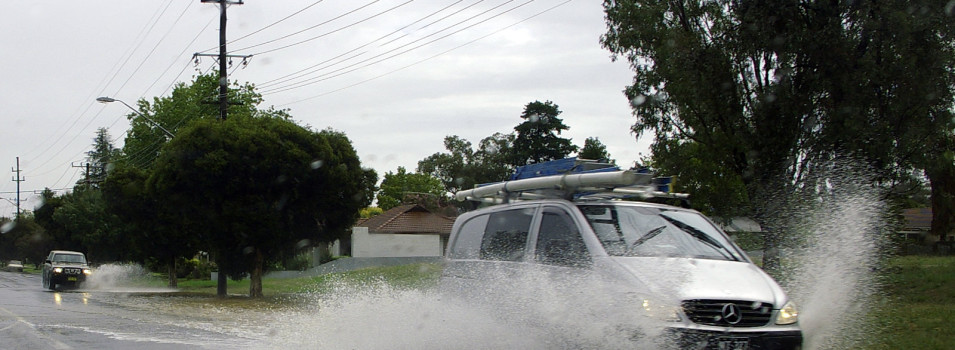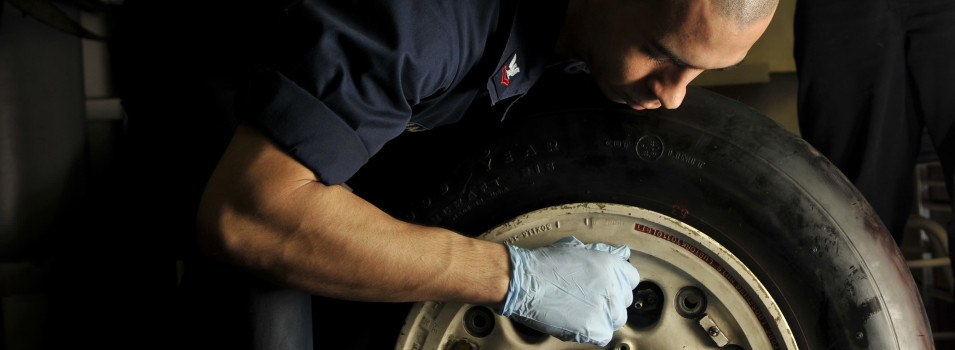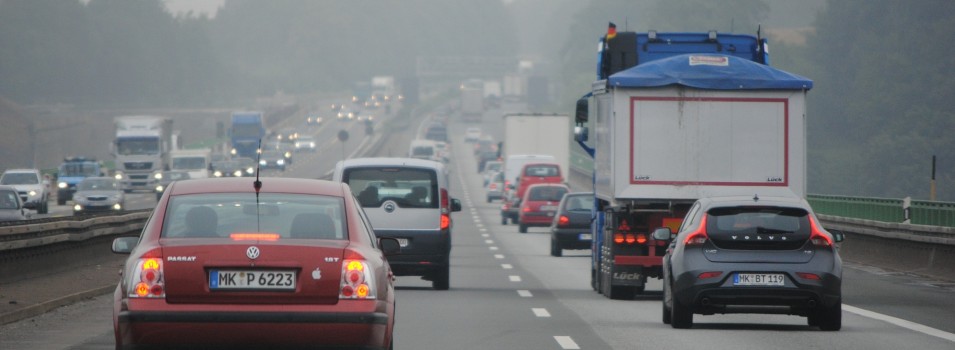Monthly Archives for October 2015

What is Hydroplaning?
Hydroplaning refers to the skidding or sliding of cars, especially on a wet surface or road. It occurs when the water encountered by the tires is much more than they can handle, thus losing traction and resulting to skids, loss of steering, power control, and braking.
Because of this, rubber tires were designed to have threads or grooves to help them channel water beneath the tire. These grooves create higher friction, and with such resistance, there is a minimized chance of hydroplaning. Although your tires may be grooved and designed against hydroplaning, it would still be safe to assume there are slim chances that you will still experience skids.
During rainy days, every driver must be wary especially in the first 10 minutes of light rain. This is when the rain mixes with the oil and dirt on the road surface that might cause vehicles running very fast (35mph) to skid and hydroplane. Always remember that a car that hydroplanes isn’t only a hazard to the person driving the car, but also to the other vehicles on the road. This can result in serious road accidents.
Here are a few tips anyone can do to make sure you avoid hydroplaning:
1. Make sure you don’t have flat tires and that they are always properly inflated.
Also, make sure your tires have good tread, otherwise there will be less traction, and you will become more prone to hydroplaning.
2. Rotate and replace tires when necessary.
Some tires get worn out pretty easily in some cars, so rotating your tires once in a while could help reduce the damage and give your tires a longer lifespan. Rotate tires for every 3000 miles of a road trip. Also, if you have a front wheel drive vehicle, you must consider tire rotation seriously, since, in this case, front tires get worn out faster and more differently from back tires.
3. When there is ta lot of water on the road or when there is rain, slow down to give your tires friction.
The faster you run, the more likely you are to hydroplane. It’s especially important to go slowly if you see standing water.
4. Stay away from puddles and standing water.
Always look out for puddles since the greater the amount of water, the greater the chance to hydroplane. This means you should avoid driving in outer lanes since that is where water usually accumulates. Try to follow the tracks left by the cars before you, since there is a smaller probability of water building up in areas experiencing full tire action.
5. Turn off cruise control.
You are better off without cruise control during rainy days, especially if it’s heavy downpour. Turning off cruise control will direct your focus to the present and will make you more aware of he surroundings.
6. Avoid hard braking.
If you have anti-lock brakes then you can brake as you usually do, but if you don’t, then make sure you brake in small gentle pumps. Make sure you don’t lock the wheel, or you will surely skid and hydroplane.
7. Try not to make sharp or quick turns.
Always be careful when taking turns. Doing so sharply will most likely result to hydroplaning since your tires will have less time to gain traction and will therefore skid.
As you can see, your tires play a very critical role in your drive. If you are a tire store, an auto recycler or a car dealer, it is important to know this information so that you can give your customers appropriate recommendations when they choose their tires. Manage your tire business efficiently through an effective and proven holistic system where you can organize, advertise and invoice tires in one easy step. Check out our system and avail of our free trial today!

Tire Maintenance 101
Being well prepared before getting behind the wheel is the cornerstone of being a good driver. Checking gas levels, lights, brakes, tires and more are vital to a safe and pleasant drive.
Today, we’d like to talk about an important feature of your car: your tires. There are many benefits of maintaining your tires properly:
• Tire maintenance should always be on top of your list. Tires are among the most crucial components of your vehicle. Improper tire conditions can cause accidents and injuries
• Tire maintenance helps extend the life of your tires. Longer tire life means you save money by buying tires less often.
• Did you know that under-inflated tires also cost you more fuel? Under-inflated tires have a higher rolling resistance that makes your engine work harder to keep you going at the same speed.
It is recommended that you inspect your tires regularly, especially before driving out. You may overlook less obvious damage without a thorough inspection so be sure to schedule them more often with your local tire shop. Check tire pressure and do regular maintenance routines such as tire rotation, alignment, and visual inspections.
Always check for underinflated or flat tires, since they increase risks on the road. Under-inflated tires do not only increase your fuel usage, but they also provide less traction. During rainy seasons, skidding and sliding are even more likely with worn out or underinflated tires. Make sure you check each tire’s pressure before trips, to save yourself money and reduce the chances of an accident.
Tire maintenance is a serious task – it starts from the tire purchase to regularly servicing the customer. Give your customers an easy way to choose tires online. If you are a tire store, an auto recycler or a car dealer, manage your business efficiently through an effective and proven holistic system where you can organize, advertise and invoice tires in one easy step. Check out our free trial and save on labor costs, increase your sales and make your job easier today!
Safety Tips For Driving
The road is a jungle, they say. As a driver, you should always opt for safety above all else. There are lots of accidents resulting from reckless driving, and you may want to steer clear of all those risks. The question is, how exactly can you prepare for a safe drive? And what are some driving tips you can use to avoid getting involved in an accident? Let us count the ways:
1. Before you go out on the road, always check your tires. They are the ones most usually overlooked but are of the greatest importance since your tires are the only parts of your car directly in contact with the road. You may want to make sure they are properly inflated and are in proper alignment. Not doing so could to get into trouble later.
2. Check your batteries. Make sure the terminals are clean and the connection is tight. A little baking soda will do the trick to clean a dirty terminal, so make sure your batteries are in good condition and well serviced. Driving a car with poor battery invites a breakdown usually at the most inconvenient times.
3. Also, check your fuel level. Running out of fuel is more common than you may think. Fuel gauges are not always entirely accurate; be sure you always have a minimum of one-quarter of a tank of fuel at all times before proceeding on your trip.
4. Check the brakes. There are too many accidents due to break failure. Be sure to have them physically checked by your mechanic. Worn out, damaged or malfunctioning brakes invite disaster.
5. Finally, follow road rules. Respect street lights and stop signs. Don’t tailgate! Leave a two-second gap between you and the car before you. In times when visibility becomes a problem, you should leave a four-second gap, especially during rainy days or foggy conditions.
Use your turn signal indicators. This will let other motorists know what you plan to do and will give them time to decide which way to go. Drive smart and safe. Hasty decisions will result in potential accidents risking your life and the lives of those around you.
If you happen to be a tire store, make sure that you recommend the most appropriate tire for your customer’s needs. With such a wide variety of tire makes and models, It’s important to give them the best advice. Have the information at hand with an easy to use tire inventory system. Try out our new system where you can organize, advertise and invoice your tires in one easy step. Check out all the benefits with our trial and provide that excellent customer service today!

Road Safety 101
Road safety is one thing responsible drivers should (if they already don’t) know about. Knowing what to do in different road situations cuts the line between good and reckless drivers. Road safety should be observed to avoid accidents and crashes. This way, you protect not just your car, but most importantly, your life and others’ as well.
Road safety begins even before you hit the road. You should be aware of certain preparations and inspections you make before deciding your vehicle is in a proper and safe condition. Every driver should do maintenance checks and make sure all parts of the vehicle are responsive and do not malfunction. With this, we reduce the risks of crashes and some unexpected situations in the middle of the road, which will not only cause delay to your travel but also put your life to risk.
Make sure your tires, batteries, brakes, and engine are in good condition. Tires should be properly inflated, and are in proper alignment. Brakes should be responsive, and your batteries and engines clean and working fine. Also, bring a car emergency kit just in case you get stuck in some problems. This way, you are less likely caught unprepared.
Road safety asks that you comply with the rules of the road. Follow guidelines and signs, traffic lights and never ignore pedestrian alerts. Always be aware of your surroundings. Always leave a gap before you and the vehicle before you. You are less likely to bump and involve in a heated argument or worse, a deadly crash.
In case of rainy days and heavy downpour, and also with fog, be sure to slow down to avoid skids and slides. Hydroplaning occurs during rainy season most usually, and you should know that the faster you go, the more prone you are to hydroplane. Make sure you run just fast enough for your tires to gain traction and connect with the road surface.
Always stay on your side of the road. If you ever have to take a turn, make sure you turn on your indication lights so the motorists after you are aware of the direction you’re taking. Remember the signs and things you should do in various road situations, and you are sure to be understood by other motorists and avoid minor crashes. You will also minimize traffic problems by being a responsible driver yourself.
As we mentioned, road safety starts even before you hit the road. This means, everything and anything that is connected to your car should be appropriate for its make. One of the critical element is choosing your tire whether this may be depending on the weather condition or your usage.
If you are a tire store, an auto recycler or a car dealer, it is wise to know what specific tires to recommend to your customers. However, with the many types and brands of car tires, managing your inventory and your database can be a problem. But don’t fret! You now have the option to manage your business efficiently through an effective and proven holistic system where you can organize, advertise and invoice tires in one easy step. All you need to do is to check out our free trial and see how easy it is to cater to your customers with this user-friendly system! Try it today!
